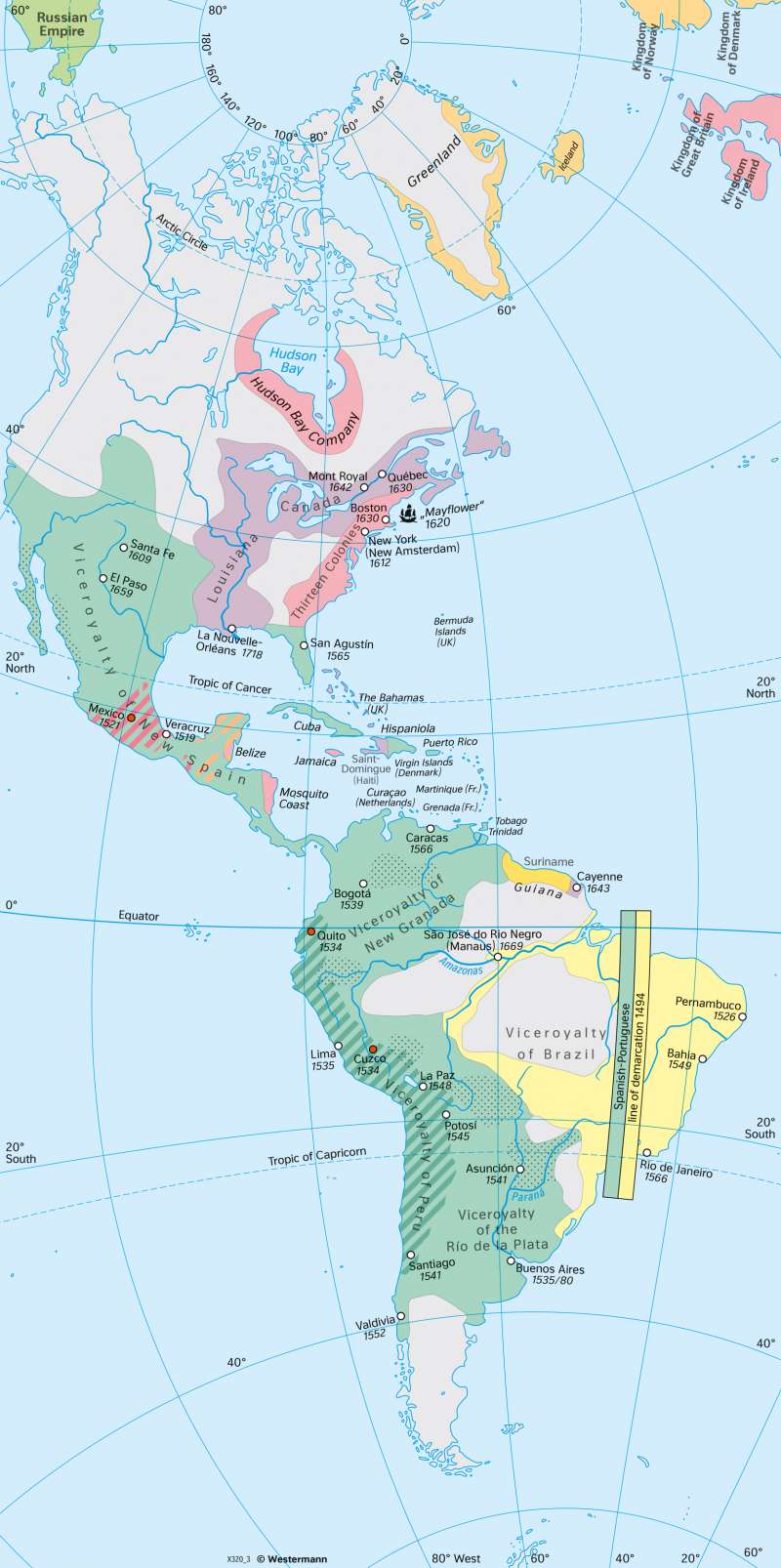The Americas - European colonisation (mid 18th century)
Immigration shaping the political landscape
978-3-14-100890-6 | Page 170 | Ill. 1

Overview
In 1494, at the instigation of Pope Alexander VI, the maritime powers of Portugal and Spain had signed the Treaty of Tordesillas, which divided the world into Spanish and Portuguese spheres of interest in order to prevent an armed confrontation between the two powers. After the signing of this treaty, Spain moved from its original concept of mere trade expansion to one of settlement colonisation and land seizure in the New World. The founding of the Audiencia of Santa Domingo in 1511 laid the foundation for an organised colonial administration, which was expanded after the conquest of Mexico by Hernando Cortés and Peru by Francisco Pizarro through audiencias in Mexico, Panama, Guatemala, Colombia, Peru, Bolivia, and Chile, among others. Spain became the most powerful colonial power in the New World.
The eastern half of Brazil belonged to the Portuguese crown. Portuguese bases were established at points along the coast, but the attempt to promote colonial development by the state through a system of land grants failed. It was only through the initiative of the privately organised and paramilitary Bandeiras, who penetrated into the interior at the end of the 16th century in pursuit of precious metals and Indian slaves, that the Portuguese colonial possessions were opened up.
European colonial powers
The other European powers became active in the New World later. In North America, initial colonisation attempts failed due to harsh living conditions, disease, resistance from the indigenous population and rivalries between the European powers. Despite the founding of St. Augustine in Florida (1565) by the Spanish, the actual history of settlement here did not begin until the early 17th century. In 1606, James I of England issued a charter to the London Company to establish colonies. Jamestown (1607) became the nucleus of the economically profitable colony of Virginia through tobacco cultivation. In 1620, the Pilgrims set sail on the Mayflower to settle New England. In 1667, England exchanged its meanwhile acquired claims to Suriname for the Dutch New Amsterdam (New York). The areas around Hudson Bay were developed after an English fur trading company obtained sovereignty and trading rights there in 1670. Around the middle of the 18th century, England also claimed Belize, the Mosquito Coast, and the islands of Jamaica, Trinidad, Tobago, Barbados, and the Bahamas.
The first significant French founding was that of Québec (1608) on the St Lawrence River. Through the fur trade and the Indian mission, the French penetrated deeper and deeper inland to the Great Lakes and the Mississippi basin. Hoping to find a route to the Pacific, they reached the mouth of the Mississippi in 1682, and in 1718 they founded New Orleans. France also gained Guadeloupe and Martinique and claimed a number of Antilles islands.
In the French and Indian War (1754-1763), a colonial war within the Seven Years' War in Europe, Britain and France fought with their respective Indian allies for supremacy in North America. The Peace of Paris of 1763 sealed the end of French colonial rule in North America east of the Mississippi, while England gained Florida, which had previously been Spanish.
Among the first colonists, the enslavement of Indians was considered legitimate. However, mistreatment and epidemic diseases led to a catastrophic decline of the indigenous population within a short time. In order to be able to maintain the plantation economy, the Portuguese brought African slaves into the country from 1538 and thus laid the foundation for the lucrative Atlantic "triangular trade" between Europe, Africa and America. In this trade, weapons, metal goods, cloth and precious objects from Europe were exchanged in Africa for slaves, who were taken to the New World and traded there for precious metals, raw materials, and luxury items for Europe. The slave trade, to which at least ten million Africans fell victim according to estimates, was not officially abolished by most states until the late 18th century but existed in the form of illegal human smuggling until the last third of the 19th century.




